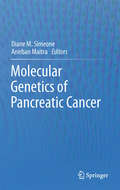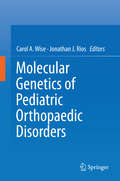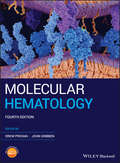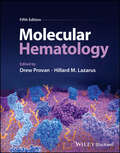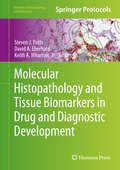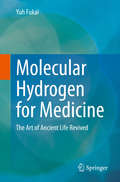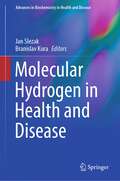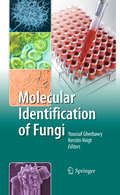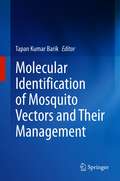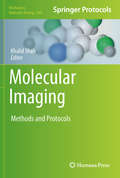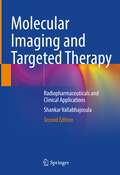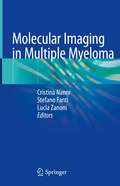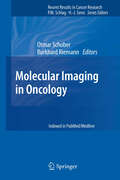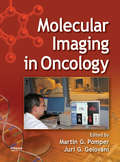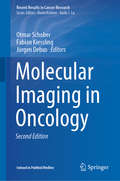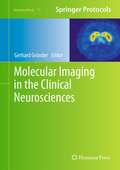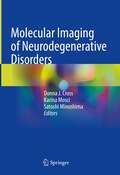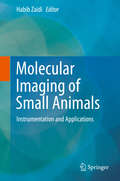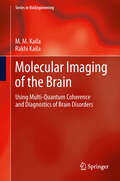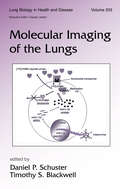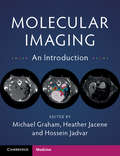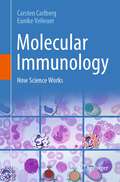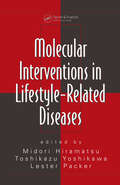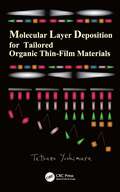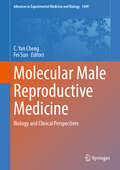- Table View
- List View
Molecular Genetics of Pancreatic Cancer
by Diane M. Simeone Anirban MaitraPancreatic cancer is a formidable disease, and advances in early detection and improved therapeutics have been slow to come forth. With new advances in molecular genetics in the field of pancreatic tumorigenesis, it is an opportune time to use these recent discoveries to enhance our understanding of pancreatic cancer biology and to improve outcomes in patients. In this volume, leading experts in the field shed light on these findings describing the mutational landscape of pancreatic cancer, including new inroads into our understanding of familial pancreatic cancer, epidemiology, the biology of K-ras signaling, and the emerging contribution of epigenetic alterations to disease initiation and progression. The distinctive pancreatic cancer-stroma ecosystem as determined by the dynamic interplay of inflammation, hallmark mutations, EMT, and cancer stem cells is described, and implications of these interactions in the context of development of novel, personalized therapeutic options are explored.
Molecular Genetics of Pediatric Orthopaedic Disorders
by Carol A. Wise Jonathan J. RiosIn the past two decades we have seen a surge forward in understanding the genetics and biochemistry underlying many pediatric orthopaedic disorders. A few projects have even progressed into the realm of clinical trials that are primarily aimed at controlling progressive disease. Meanwhile, genomic technology development has outpaced expectations and is enabling gene discovery for disorders that were previously intractable with traditional genetic methods. Included in this latter category are common disorders that display multigenic inheritance, sporadic disorders, and very rare conditions that are difficult to ascertain. Simultaneously, the study of pediatric orthopaedic disorders has been continuously refined and updated, highlighting a number of likely genetic conditions that are as yet unsolved. Molecular Genetics of Pediatric Orthopaedic Disorders updates researchers and clinicians of new developments of pediatric orthopaedic genetics. The chapters inform the audience on the revolution in new genomic methods and the impact this is having on potential study designs and the potential to discover genetic causes of many unsolved orthopaedic conditions. Recent examples have been included of pediatric orthopaedic conditions, both rare and common, that are being solved with these new methods. The book also educates pediatric orthopedic clinicians and geneticists on our understanding of the biology of "classic" genetic diseases that were derived from prior genetic studies. Chapters include biobanks and strategies for studying very rare disorders, genes and pathways causing primordial dwarfism, and notch signaling in congenital scoliosis, and more.
Molecular Hematology
by Drew Provan John G. GribbenThe new and fully-revised volume of hematologic molecular biology for practicing and trainee hematologists Molecular Hematology is a comprehensive resource for hematologists to increase their understanding of the molecular basis of various blood diseases, their pathogeneses, and current and emerging molecular research and therapies. The impact of molecular research on the field of hematology is significant—molecular techniques are continuing to play a central role in in the diagnosis and treatment of blood diseases. Molecular characterization of genes and proteins has increased our comprehension of the causes of hematological diseases and led to the development of new drug therapies and recombinant proteins. Now in its fourth edition, Molecular Hematology has been thoroughly revised and updated to reflect current advances in molecular research. Chapters introduce and summarize specific disorders, such as hemophilia, anemia, and multiple myeloma, and illustrate the impact of molecular research on their diagnoses and treatments. Contributions written by respected clinicians and researchers offer accessible coverage of topics including lymphoma genetics, molecular coagulation and thrombophilia, platelet disorders, pharmacogenomics, and many others. Demonstrates the clinical relevance of molecular biology in hematology Provides overviews of recent advances in cancer-cell biology, with an emphasis on leukemia and lymphoma Offers new and updated chapters written by an international team of experts in the field Presents new full-color charts, graphs, and illustrations Includes access to a Wiley Companion Digital Edition providing search across the book, downloadable illustrations and notation tools Molecular Hematology is an essential volume for both trainee and practicing hematologists and oncologists, molecular biologists, and research scientists working in the field of hematology.
Molecular Hematology
by Hillard M. Lazarus Drew ProvanProvides a core knowledgebase for those with minimal exposure to hematologic molecular biology, fully revised and updated Molecular Hematology brings together the most up-to-date and reliable information on the molecular basis of major hematologic diseases. Edited and authored by leading experts in the field, this volume demonstrates the clinical relevance of molecular biology in the diagnosis and treatment of blood disorders. Concise, accessible chapters address key topics in modern hematology, such as lymphoma genetics, molecular coagulation, thrombophilia, pharmacogenomics, platelet disorders, hemophilia, anemia, and multiple myeloma. Chapters introduce and summarize specific hematologic diseases, explore the pathogenesis of the disorder, highlight new and emerging molecular strategies, and more. Now in its fifth edition, Molecular Hematology is fully revised to incorporate contemporary hematology research and practice. Entirely new chapters cover topics such as CAR-T cell technology, COVID, cancer cell biology, gene therapy and gene editing in clinical practice, as well as the impact of molecular research on the diagnosis and treatment of various malignant hematologic diseases. This edition includes updated suggested readings and a wealth of new full-color charts, graphs, and illustrations throughout. Covers the molecular biology of different blood diseases, their pathogeneses, and current molecular research and therapies Illustrates the impact of molecular research on hematologic investigations and therapeutics Discusses how progress in basic science and therapeutics has improved the diagnosis and care of patients with various hematologic disorders Surveys recent developments in cancer-cell biology, with an emphasis on leukemia and lymphoma Includes access to a companion Digital Edition providing search across the book, downloadable illustrations, and notation tools Molecular Hematology is a must-have resource for established and trainee clinicians, clinical scientists and researchers, medical students, and upper-level undergraduates in the fields of hematology, oncology, and molecular biology.
Molecular Histopathology and Tissue Biomarkers in Drug and Diagnostic Development
by Steven J. Potts David A. Eberhard Keith A. WhartonMolecular Histopathology and Tissue Biomarkers in Drug and Diagnostic Development gathers diverse experts to present state of the art guidance and application of histopathology in drug development settings ranging from discovery research to human clinical trials. While many current applications of quantitative histology and molecular pathology in the biopharmaceutical industry are focused on oncology, this volume in addition explores non-oncologic disease areas including nonalcoholic steatohepatitis, arthritis, celiac disease, myeloproliferative disorders, neurology, and wound healing. The authors write from years of experience in diagnostic practice and pharmaceutical drug development, aiming to educate pharmaceutical and academic scientists how to best use tissue to diagnose disease and improve the process of drug development. As part of the Methods in Pharmacology and Toxicology series, this volume is designed to provide wisdom and examples that others can follow and apply as part of drug development. Comprehensive and practical, Molecular Histopathology and Tissue Biomarkers in Drug and Diagnostic Development will inform and enlighten both tissue-focused and non-tissue-focused drug development professionals about better use and interpretation of the multidimensional data contained in a tissue biopsy.
Molecular Hydrogen for Medicine: The Art of Ancient Life Revived
by Yuh FukaiThis book provides a comprehensive account of the current status of molecular hydrogen medicine, a young field that emerged with the discovery that inhalation of hydrogen gas leads to the elimination of harmful reactive oxygen species in rats. Various physiologic effects have since been demonstrated, and possible medical applications identified. Numerous clinical projects have now been undertaken, yielding startling results. Despite this, molecular hydrogen medicine remains underappreciated among the medical community at large. The author aims to rectify this situation by fairly but critically evaluating the potential clinical benefits based on the latest scientific research. In addition, the observed physiological effects of hydrogen gas are considered within the broad context of the evolution of life on earth, offering new perspectives and helping to place molecular hydrogen medicine legitimately within the framework of life sciences. Written in an accessible manner, the book will be of value to students, researchers, clinicians, and the general public.
Molecular Hydrogen in Health and Disease (Advances in Biochemistry in Health and Disease #27)
by Jan Slezak Branislav KuraMolecular hydrogen (H2) has emerged as a promising therapeutic and preventive medical gas. Hydrogen gas has garnered significant attention in recent years due to its remarkable antioxidant and anti-inflammatory properties. H2 exhibits exceptional pharmacokinetics, swiftly traversing cellular biomembranes to access subcellular organelles indirectly regulating hormones and cytokines through various signal transduction pathways. H2 has the potential to address a wide range of issues, including clinical medical treatment in the areas of healthcare: myocardial ischemia, heart failure, cardiac arrest, metabolic syndrome, advanced-stage cancer, inflammatory diseases, Alzheimer's dementia, aging-related disorders, sports activities, and even beauty, agriculture, etc.Selected world-known authors in the field provide readers with a comprehensive overview of molecular hydrogen's remarkable effects and its physical, chemical, and therapeutic properties and potential in biomedical applications. This contributed volume fills the current gap in information and is intended for everyone who wants to be better informed about the wide possibilities of using molecular hydrogen. However, it is mainly intended for use by medical students, physiologists, pharmacologists, physicians, and other healthcare personnel who can use molecular hydrogen to improve the health of everyone who needs it.
Molecular Identification of Fungi
by Youssuf Gherbawy Kerstin VoigtFungi enjoy great popularity in pharmaceutical, agricultural, and biotechnological applications. Recent advances in the decipherment of whole fungal genomes promise an acceleration of these trends. This timely book links scientists from different parts of the world who are interested in the molecular identification of fungi combined with the exploration of the fungal biodiversity in different ecosystems. It provides a compendium for scientists who rely on a rapid and reliable detection of fungal specimens in environmental as well as clinical resources in order to ensure the benefit of industrial and clinical applications. Chapters focus on the opportunities and limits of the molecular marker-mediated identification of fungi. Various methods, procedures and strategies are outlined. Furthermore, the book offers an update of the current progress in the development of fungal molecular techniques, and draws attention to potential and associated problems, as well as integrating theory and practice.
Molecular Identification of Mosquito Vectors and Their Management
by Tapan Kumar BarikThis book summarizes the recent advancements in identifying the mosquito vectors and discusses various strategies for their control. The book describes various molecular taxonomic methods, including DNA barcoding and single nucleotide polymorphism-based machine learning approach, which are used for the identification of mosquito vectors. It also presents the various mosquito control methods, namely, phytochemicals, Bacillus thuringiensis toxins, nanotechnology, biological control agents, and environmental management strategies. It also highlights the importance of various repellents that are used for protection from different kinds of mosquito vectors. Finally, the book offers a comprehensive yet representative description of challenges associated with mosquito vector-borne diseases. The book is a useful resource for medical entomologists, health workers, and researchers working in mosquito-control and vector-borne diseases.
Molecular Imaging
by Khalid ShahIn recent years, molecular imaging techniques have grown to be invaluable tools for molecular biology research and, to a more modest extent, clinical medicine. In Molecular Imaging: Methods and Protocols, expert researchers explore the latest advances in the field, describing a rich variety of practical procedures and methods for diverging imaging technologies. Chapters are divided into sections that cover the imaging of basic molecular and biochemical events, imaging in pre-clinical settings, and imaging in clinical settings. Composed in the highly successful Methods in Molecular BiologyTM series format, each chapter contains a brief introduction, step-by-step methods, a list of necessary materials, and a Notes section which shares tips on troubleshooting and avoiding known pitfalls. Comprehensive and ground-breaking, Molecular Imaging: Methods and Protocols is an essential handbook for students, established practitioners, and research fellows alike.
Molecular Imaging and Targeted Therapy: Radiopharmaceuticals and Clinical Applications
by Shankar VallabhajosulaThis book, now published in its second edition, covers a wide range of topics relating to the use of radiopharmaceuticals. The basics of nuclear chemistry, radiochemistry, and radiopharmacology are considered in detail, regulatory issues are reviewed, and potential applications in drug development, translational medicine, clinical diagnostics, and targeted therapy are discussed. Compared with the first edition, the chapters on targeted therapy with alpha- and beta-emitting radiopharmaceuticals and theranostics are completely new. Other chapters have been updated and revised as necessary. Radioisotope-based molecular imaging probes (radiopharmaceuticals) provide unprecedented insights into biochemistry and function in both normal and diseased states of living systems, with unbiased in vivo measurements of regional radiotracer activities offering very high specificity and sensitivity. No other molecular imaging technology, including functional magnetic resonance imaging, can provide such high sensitivity and specificity at a tracer level. This book, written by an experienced radiochemist and scientist, offers valuable insights into the full range of applications of this technology.
Molecular Imaging in Multiple Myeloma
by Stefano Fanti Cristina Nanni Lucia ZanoniThis book provides a comprehensive overview of the importance of molecular imaging in multiple myeloma, with detailed explanation of its clinical impact. Other important features are the definition of criteria that will aid PET/CT interpretation; identification and explanation of the most frequent pitfalls; a brief overview of the advantages and limitations of DWI MR imaging, still an experimental technique in multiple myeloma; and examination of the possible role of emerging PET tracers. When appropriate, clinical cases are used to illustrate key teaching points. All physicians involved in oncological imaging should regularly reassess and update their routine practice in the evaluation of multiple myeloma patients. This is especially true now, given the recent clarification by the International Myeloma Working Group (IMWG) of the criteria for bone damage requiring therapy and the emerging data supporting the role of the newer functional imaging techniques in predicting outcome and/or evaluating response to therapy. In this challenging context, Molecular Imaging in Multiple Myeloma will be of high value for nuclear medicine physicians, radiologists, and hematologists.
Molecular Imaging in Oncology
by Burkhard Riemann Otmar SchoberThe impact of molecular imaging on diagnostics, therapy, and follow-up in oncology is increasing steadily. Many innovative molecular imaging probes have already entered clinical practice, and there is no doubt that the future emphasis will be on multimodality imaging in which morphological, functional, and molecular imaging techniques are combined in a single clinical investigation. This handbook addresses all aspects of molecular imaging in oncology, from basic research to clinical applications. The first section is devoted to technology and probe design, and examines a variety of PET and SPECT tracers as well as multimodality probes. Preclinical studies are then discussed in detail, with particular attention to multimodality imaging. In the third section, diverse clinical applications are presented, and the book closes by looking at future challenges. This handbook will be of value to all who are interested in the revolution in diagnostic oncology that is being brought about by molecular imaging.
Molecular Imaging in Oncology
by Martin G. Pomper Juri G. GelovaniWith molecular imaging becoming one the fastest growing topics in medical schools, Informa Healthcare presents Molecular Imaging in Oncology, the first comprehensive reference on molecular imaging in oncology.Giving clinicians and researchers a greater understanding of the current field, this text covers:instrumentation and techniquescancer imaging
Molecular Imaging in Oncology (Recent Results in Cancer Research #216)
by Otmar Schober Fabian Kiessling Jürgen DebusThis book discusses the most significant recent advances in oncological molecular imaging, covering the full spectrum from basic and preclinical research to clinical practice. The content is divided into five sections, the first of which is devoted to standardized and emerging technologies and probe designs for different modalities, such as PET, SPECT, optical and optoacoustic imaging, ultrasound, CT, and MRI. The second section focuses on multiscale preclinical applications ranging from advanced microscopy and mass spectroscopy to whole-body imaging. In the third section, various clinical applications are presented, including image-guided surgery and the radiomic analysis of multiple imaging features. The final two sections are dedicated to the emerging, crucial role that molecular imaging can play in the planning and monitoring of external and internal radiotherapy, and to future challenges and prospects in multimodality imaging. Given its scope, the handbook will benefit all readers who are interested in the revolution in diagnostic and therapeutic oncology that is now being brought about by molecular imaging.
Molecular Imaging in the Clinical Neurosciences
by Gerhard GründerWhile researchers with Positron Emission Tomography (PET) and Single Photon Emission Computed Tomography (SPECT) essentially addressed questions from the whole spectrum of cardiology, oncology, and the neurosciences, it was most notably the latter that provided completely new insights into physiological and disturbed human brain function. In Molecular Imaging in the Clinical Neurosciences, experts in the field provide the reader with up-to-date information on the basic principles of molecular imaging and its major applications in the clinical neurosciences. Beginning with a section offering a comprehensive review of the methodological foundations from physics, chemistry, and mathematics including mathematical modeling, essential for meaningful data analysis, this detailed volume then continues with sections on the major biological principles and neurochemical targets relevant in current neuroimaging research and the major clinical applications from the fields of psychiatry and neurology. Written for the popular Neuromethods series, this work contains the kind of key description and implementation advice that guarantees successful results. Authoritative and cutting-edge, Molecular Imaging in the Clinical Neurosciences serves as a helpful source of knowledge for both basic and clinical scientists from psychology, psychiatry, neurology, nuclear medicine, nuclear chemistry, and the associated disciplines, all of which makes molecular imaging such a rewarding, interdisciplinary field of work.
Molecular Imaging of Neurodegenerative Disorders
by Donna J. Cross Karina Mosci Satoshi MinoshimaThis book provides a comprehensive review of the role of molecular imaging in neurodegenerative diseases. A growing field, molecular imaging of neurodegeneration is becoming increasingly relevant with an aging population, and this book serves to provide both an introduction to the concept and background of neurodegeneration and an update on the most recent imaging advances.Throughout, chapters will review current applications of neuroimaging in neurodegenerative disorders, like dementia and movement disorders, and increase knowledge of quantification and semi-quantification methods for neuroimaging. Imaging methods such as PET/CT and PET/MR are covered, as well as more advanced technologies like artificial intelligence algorithms and novel radiotracers. Chapters are also intended to improve competency in reporting and interpretation skills with structured information on current practice. The book concludes with a collection of up to date practice cases for the interpretation of neurodegeneration in nuclear medicine imaging.This is an ideal guide for nuclear medicine physicians, neuroradiologists, neurologists, residents, trainees, and related medical professionals caring for patients with neurodegeneration.
Molecular Imaging of Small Animals
by Habib ZaidiThis book examines the fundamental concepts of multimodality small-animal molecular imaging technologies and their numerous applications in biomedical research. Driven primarily by the widespread availability of various small-animal models of human diseases replicating accurately biological and biochemical processes in vivo, this is a relatively new yet rapidly expanding field that has excellent potential to become a powerful tool in biomedical research and drug development. In addition to being a powerful clinical tool, a number of imaging modalities including but not limited to CT, MRI, SPECT and PET are also used in small laboratory animal research to visualize and track certain molecular processes associated with diseases such as cancer, heart disease and neurological disorders in living small animal models of disease. In vivo small-animal imaging is playing a pivotal role in the scientific research paradigm enabling to understand human molecular biology and pathophysiology using, for instance, genetically engineered mice with spontaneous diseases that closely mimic human diseases.
Molecular Imaging of the Brain
by M. M. Kaila Rakhi KailaThis book examines multi-quantum magnetic resonance imaging methods and the diagnostics of brain disorders. It consists of two Parts. The part I is initially devoted towards the basic concepts of the conventional single quantum MRI techniques. It is supplemented by the basic knowledge required to understand multi-quantum MRI. Practical illustrations are included both on recent developments in conventional MRI and the MQ-MRI. This is to illustrate the connection between theoretical concepts and their scope in the clinical applications. The Part II initially sets out the basic details about quadrupole charge distribution present in certain nuclei and their importance about the functions they perform in our brain. Some simplified final mathematical expressions are included to illustrate facts about the basic concepts of the quantum level interactions between magnetic dipole and the electric quadrupole behavior of useful nuclei present in the brain. Selected practical illustrations, from research and clinical practices are included to illustrate the newly emerging ideas and techniques. The reader should note that the two parts of the book are written with no interdependence. One can read them quite independently.
Molecular Imaging of the Lungs
by Daniel P. Schuster Timothy S. BlackwellThis authoritative reference reviews current and emerging molecular imaging modalities that are expected to impact the detection and treatment of lung diseases in the near future-including applications in gene expression and inflammation imaging; the imaging of pulmonary cytokine regulation; the molecular imaging of angiogenesis, the airways, and l
Molecular Imaging: An Introduction (The\clinics: Radiology Ser. #Volume 4-2)
by Michael Graham Hossein Jadvar Heather JaceneEngage with the visual world of disease with this accessible introduction to molecular imaging. This book provides users of all levels with the characterization and measurement of biological processes on a cellular level, functioning within humans, and other living systems. This important new introduction to the field will enable the reader to recognize the major methods, modalities and varied applications of molecular imaging in an efficient and effective way. Featuring techniques from areas such as nuclear medicine, magnetic resonance spectroscopy, optical imaging, and nanotechnology, the book also covers the current movement towards precision medicine thereby driving exceptional hospital care, worldwide. Molecular Imaging provides valuable insight into the properties that improve patient diagnosis. Serving to inform experienced physicians, students, and beginners alike, this convenient introduction is tailored to an individual with the desire to effectively grasp the basic concepts of molecular imaging, under the constraints of a busy professional career.
Molecular Immunology: How Science Works
by Carsten Carlberg Eunike VelleuerThis textbook aims to describe in a condensed form the essentials of molecular immunology behind bacterial infections, the microbiome, viral infections (such as influenza and COVID-19), organ transplantations, autoimmunity, allergy and tumor immunology. The book emphasizes the impact of immunology in maintaining our health and preventing disease. Our immune system protects us not only from severe consequences of infectious diseases and getting cancer, but is also able to harm us severely via sepsis, cytokine storms and anaphylactic shocks. Molecular understanding of immunology should allow the reader a more rational handling of common diseases, most of which are associated with chronic inflammation.
Molecular Interventions in Lifestyle-Related Diseases
by Toshikazu Yoshikawa Lester Packer Midori HiramatsuThe Japanese Ministry of Health, Labor and Welfare, officially recognizing that various risk factors for disease are present in our environment, has proposed the concept of lifestyle-related diseases. These include those diseases that are tied to such lifestyle choices as excessive alcohol consumption, cigarette smoking, exposure to stress, and poo
Molecular Layer Deposition for Tailored Organic Thin-Film Materials (Optics and Photonics)
by Tetsuzo YoshimuraThis book provides concepts and experimental demonstrations for various types of molecular layer deposition (MLD) and organic multiple quantum dots (organic MQDs), which are typical tailored organic thin-film materials. Possible applications of MLD to optical interconnects, energy conversion systems, molecular targeted drug delivery, and cancer therapy are also proposed. First, the author reviews various types of MLD processes including vapor-phase MLD, liquid-phase MLD, and selective MLD. Next, he introduces organic MQDs, which are typical tailored organic thin-film materials produced by MLD. The author then describes the design of light modulators/optical switches, predicts their performance, and discusses impacts of the organic MQDs on them. He then also discusses impacts of the organic MQDs on optical interconnects within computers and on optical switching systems. Finally, the author presents MLD applications to molecular targeted drug delivery, photodynamic therapy, and laser surgery for cancer therapy. This book is intended for researchers, engineers, and graduate students in optoelectronics, photonics, and any other field where organic thin-film materials can be applied.
Molecular Male Reproductive Medicine: Biology and Clinical Perspectives (Advances in Experimental Medicine and Biology #1469)
by C. Yan Cheng Fei SunThis book bridges the gap of basic research in male reproductive biology and its relationship to clinical studies. Bringing together a group of senior investigators with decades of experience in research and clinical investigation and keen interest in collaboration between the two areas, this book provides a balanced treatment of technical and basic research insights and cutting-edge findings, while introducing new ideas for clinical applications of this research. Section I is devoted to clinical aspects including testis biology, prostate biology, and spermatogenesis by senior investigators of male infertility treatment, particularly non-obstructive azoospermia. Section II presents the latest findings in male reproductive biology from a basic research perspective, as well as covering cutting-edge technology such as scRNA-Seq, scATAC-Seq, DNA chromatic accessibility and organization studies, genetic models, cell biology, molecular biology, and biochemistry on testis biology, and spermatogenesis. This book offers not only a cohesive summary of new findings and concepts in basic and clinical male reproductive research, it analyzes and assembles these concepts into a roadmap for the next decade of translational research, bringing lab discoveries to the bedside.
